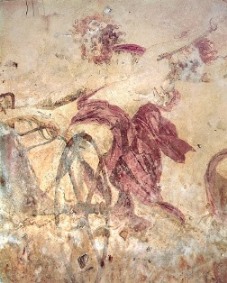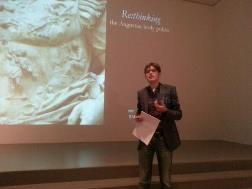
KHAN was set up in 2013 as part of the strategic partnership between the universities of Kiel (CAU), Hamburg (UH) and Aarhus (AU). All three universities have strong research traditions within the field of Classical Archaeology, especially within the study of ancient art and visual culture, and further collaboration between them is strongly desired. The chief aims of the network are to develop new approaches to the study of ancient visual culture as well as strengthen collaboration between faculty and students at the three involved universities, and finally to advance further joint research in the future. Participants of the Sacred Travel project are active in KHAN as part of our efforts to develop common methods for the study of ancient visual culture.
Our first, exploratory workshop was held in Aarhus on 14 June 2013 with presentations from Georg Gerleigner (Image and Inscription on the Eurymedon Vase), Sine Saxkjær (Between Indigenous Ethnicity and Greek Material: On Cultural Processes in the Sibaritide), Stephan Faust (The Visual Culture of Dynastic and Aristocratic Tombs in the Eastern Mediterranean – 6th to 4th Century B.C.), Signe Krag (The Visibility of Females in Civic and Religious Spaces in Palmyra) and Troels Myrup Kristensen (Myth and Metamorphosis: Visions of the Afterlife on Egyptian Textiles).
A second and larger workshop (KHAN2) was held at the Kunsthalle in Kiel on 21-22 March 2014 with the theme “Exploring Methods in Ancient Visual Culture Studies.” This workshop explored how methods of Visual Culture Studies can be applied in order to contribute to our understanding of the meaning of images and art in ancient societies. For many years, archaeological research has particularly concentrated on the social, religious, and cultural functions of statues and portraits, on forms of representation, and related aspects that are important for answering historically based questions. While there can be no doubt that this aim is still valid, Visual Culture Studies provide a fresh approach which particularly allows additional insights concerning the use, perception, and interaction of image-bearing artefacts or architecture. Thus discussing the dynamics of images, the workshop investigated the possibility of reconstructing the role of decorated goods during performances such as funerary practices.

To get us started on these complex issues, Michael Squire (King’s College London) first gave a keynote lecture on Rethinking the Augustan Body Politic, which was followed by two further keynotes by Martina Seifert (UH), Hidden Structures in Visual Art: A Case Study on Greek Vase-Paintings, and Annette Haug (CAU), Was ist ein Bild? “Bilder” und “Ornamente” auf frühgriechischen Gefäßen. We then heard 8 papers by graduate students and faculty from Hamburg, Kiel, Odense, and Aarhus. This bodes well for future collaboration, and the steering committee is currently planning ahead for KHAN3, which will be a more focused symposium on the future of the visual in Classical archaeology.
KHAN Steering Committee: Stephan Faust (UH), Georg Gerleigner (CAU), Troels Myrup Kristensen (AU)